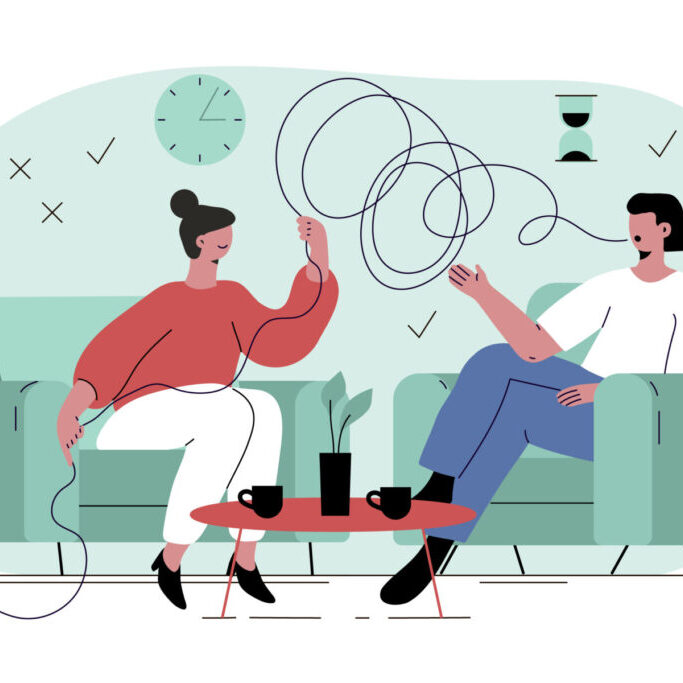Worry and Anxiousness: What’s the Difference?

People often confuse worry and anxiousness, but they are distinct psychological states. Both cause general unease, but the way we experience them and the impact on our mental health differs.
In this article, our anxiety therapists cover how to manage anxiety and anxiousness, including: recognizing the difference between normal worry and anxiousness, countering negative thoughts, practicing relaxation, seeking support, and consulting a professional.
Differentiating Normal Worry from Anxiety and Anxiousness
Managing anxiousness starts with understanding the difference between normal worry and excessive fear. Take health anxiety (i.e., hypochondria) for example. It’s normal to be concerned about your health, but health anxiety exceeds this. People with health anxiety – despite the presence of a medical reason – may experience health-related obsessive thoughts, excessive online symptom searches, fear of illness-causing activity avoidance, frequent doctor visits, concentrating on minor physical symptoms, perceiving minor symptoms as severe illness signs, or even panic feelings.
At its core, normal worry is rooted in reality, while unfounded or distorted fears (even if they feel real) indicate anxiousness and anxiety.
Consider these differences:
- Focus: Worry focuses on specific thoughts, while anxiety is a diffuse feeling throughout the body. In fact, anxiety typically provokes greater cardiovascular response than worry, causing feelings throughout the body.
- Scope: Worry is about a specific concern, while anxiety is a general feeling of unease.
- Control: Worry can be controlled through problem-solving, while anxiety is often difficult to control.
- Impact: Worry causes mild emotional distress, while anxiety can lead to severe distress.
- Basis: Worry is triggered by realistic concerns, while anxiety may stem from unrealistic fears.
- Duration: Worry is typically temporary, while anxiety can linger.
What does your thinking have to do with anxiety?
Challenging negative thoughts is key in anxiety management. Anxiety sufferers often engage in distorted thinking and make hasty conclusions. Identifying these thought patterns and questioning them is crucial.
Some common cognitive distortions include
- All-or-nothing thinking: Seeing things as either black or white, without any shades of gray.
- Overgeneralization: Drawing broad conclusions from limited experiences.
- Mental filter: Focusing on the negatives and disregarding the positives.
- Disqualifying the positive: Invalidating positive experiences and accomplishments.
- Mind-reading: Assuming to know what others are thinking without any evidence.
- Fortune-telling: Predicting the worst-case scenarios with certainty.
- Magnification or minimization: Exaggerating the negatives or minimizing the positives.
- Emotional reasoning: Believing something is true because you feel that way.
- Should/Must statements: Rigid rules and expectations placed on yourself and others
Challenging and changing these cognitive distortions, either alone or with an anxiety therapist, can help alleviate anxiety symptoms. There are several techniques that can be used to change cognitive distortions, including cognitive restructuring, mindfulness, and self-compassion. Cognitive restructuring involves questioning the accuracy of negative thoughts and seeking alternative explanations. Mindfulness involves becoming aware of thoughts without judgment or attachment. Self-compassion involves treating oneself with kindness and understanding.
Relaxation can help with anxiousness!
The fight or flight response is a physiological reaction that occurs in response to perceived danger or stress. It is an automatic response that is triggered by the sympathetic nervous system and is designed to prepare the body for action. The response is characterized by increased heart rate, rapid breathing, and the release of hormones such as adrenaline and cortisol, which mobilize the body’s resources and prepare it to either fight or flee from the perceived threat.
This response is an important adaptive mechanism that has evolved over time to protect the body from harm and to ensure survival. The problem – anxiety triggers this response, even in the absence of danger.
Relaxation can be considered an antidote to the fight or flight response, as it helps to calm the body and counteract the physiological effects of stress. Relaxation techniques such as deep breathing, meditation, and yoga can activate the opposing “rest and digest” response of the parasympathetic nervous system, reducing the levels of stress hormones such as cortisol and slowing the heart rate.
Research supports the efficacy of relaxation in reducing the negative impacts of stress on the body, including improved mood and decreased symptoms of anxiety and depression. A 2020 study published in the journal “Mindfulness” found that regular practice of mindfulness-based stress reduction (MBSR) significantly reduced stress and improved well-being in a sample of healthcare workers.
Social Support Matters
Social support has been shown to be a valuable tool in reducing anxiety and improving mental health. It can provide a sense of safety, security, and comfort, help individuals process their feelings and develop coping strategies, improve self-esteem, and buffer against anxiety and negative self-talk.
Anxiety Therapy Can Help!
Because anxiety differs from worry in that it isn’t rational, overcoming it alone can be very difficult. Working with an anxiety therapist has been shown to be an effective intervention for reducing symptoms. Numerous studies have demonstrated the efficacy of various forms of psychotherapy, such as cognitive-behavioral therapy (CBT) and exposure therapy, in treating anxiety disorders.
A study published in the Journal of Anxiety Disorders (Brosschot, Verkuil, and Verloop, 2018) found that CBT significantly reduced symptoms of generalized anxiety disorder, while a study published in the Journal of the American Medical Association Psychiatry (McEvoy et al., 2020) found that exposure therapy was effective in reducing symptoms of panic disorder.
You don’t have to experience anxiety forever. Our anxiety therapists in Lakeview offer in-person and virtual therapy appointments. If you’re ready to take the leap to eliminate your anxiety, we’d be honored to help.
This blog is made for informational and educational purposes only. It is not medical advice.
The information in this blog is not intended to (1) replace a one-on-one relationship with a qualified licensed health care provider, (2) create or establish a provider-patient relationship, or (3) create a duty for us to follow up with you.



